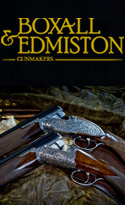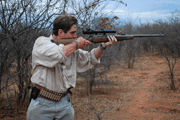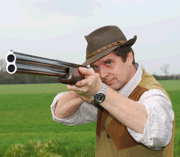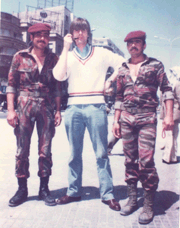Eye Dominance for Shooting
Eye dominance is a most intriguing phenomenon. Most adult men have one eye that directs the pointing process - finger or gun it makes no difference. When they point at a distant object, they will line up with one eye - usually the right eye if they are right-handed. This dominant eye, the finger tip and the selected object, will all be in a straight line. This is a natural sighting/pointing system.
For most people, shotgunning is easier, more natural and more effective keeping both eyes open. When both eyes are kept open, the perception of distance and angle is enhanced, muscular tension is minimised, and natural hand to eye co-ordination is improved (if you doubt it try catching a ball with one eye shut). However, do not believe those who tell you simplistically that everyone should shoot with two eyes open - it's just not that simple. It all depends on how you saw that finger.
About 70% of men have an eye dominance that matches their handedness. BUT, 30% do not. Most right handers have a dominant right eye and the bulk of southpaws a dominant left. These are the people who are well advised to shoot both eyes open (assuming that they are shooting from their strong shoulder). It is also possible to be 'cross-dominant' (e.g. right handed but left dominant), to have 'central vision' (neither eye dominant - a rare but distinct condition) or to have one eye which is nearly, but not fully, dominant. In these cases keeping an eye open whilst using an unmodified gun may be very poor advice which will result in consistent missing. The gun will not be pointing where the eyes are looking. The unknown error may be a yard or more.
Eye dominance is subject to change too. It can be affected by all sorts of things: stress, ill health or just staring at a computer screen for too long. Allowing the focus back to come back to the muzzles – one of the most common mistakes in shooting – can also bring about mysterious shifts in dominance. And, contrary to received wisdom, there can be a subtle connection between the ability to focus on a target and eye dominance (although one’s dominant eye is not necessarily the one with which you see best). If you find it hard to focus at distance, there will be a natural tendency to bring the focus back to the gun. Another reason to get your eyes checked once a year.
Even those with absolute eye dominance in one eye and perfect natural or corrected vision must concentrate on good focus technique. Vision is an active process in shooting – a skill as much as an ability. We must train ourselves to sustain fine focus on the bird. The bird, the bird, and nothing but the bird that must become our mantra. The natural tendency is for our vision to flick to a moving object momentarily – a primal response to danger – but not to keep the eyes focused at distance for any prolonged length of time (not even the 3 seconds or so it typically takes to shoot a bird in good style). Understanding this, is to take on board one of the great secrets of good shooting – sustained visual contact. One must train one’s eyes to shoot. Or, in the memorsble words of one friend: "STARE THE BIRD TO DEATH!"
YOUR OPTIONS
Absolute dominance in the eye looking down rib: - Shoot both eyes open and get the distance, angle and speed judging benefits of binocular vision.
Predominant dominance in the eye looking down the rib: - Keep both eyes open with extra cast, or, dim eye as the shot is taken.
Permanent and absolute cross-dominance: - close an eye, use a 'blinder' to obstruct vision to offending eye, use eye patch or modified shooting spectacles, consider a parallel rib (suitable for some forms of clay shooting), use a full cross-over stock or change shoulders.
Occasional cross-dominance: - may be caused by stress/tiredness, could be a bogey target (for which the diagnosis is to squint and/or use a pull-away or swing through technique rather than sustained lead). You might also consider whether theproblem is aggravated by poor visual discipline or your inability to focus consistently at distance. The cure for the former is improved technique, in the latter case, prescription glasses may help. An excessively low stock is also a classic cause of cross-dominance.
Central vision (neither eye dominant): - close an eye, use a 'blinder', eye patch or modified shooting spectacles, use a semi cross-over stock.
Indeterminate dominance: - close an eye, wear an eye-patch, modified shooting spectacles, oruse a 'blinder'. CHANGING SHOULDERS WILL NOT WORK.
Advanced Eye Dominance Information
Age is also a significant issue when considering eye dominance. This is a most intriguing. Most pre-pubescent boys do not have clear dominance in one eye. Post puberty, most (not all) develop absolute or predominant eye dominance in the eye corresponding to their 'handedness'. As we enter the summer and autumn of our lives things change too. Typically, somewhere between the ages of 45-60, those men who were clearly dominant in one eye may find the other begins to have a significant pull. Until diagnosed, this can result in inexplicable misses. Frequently, the cure is simple: a bit more cast on the stock, or squinting on occasion.
There are significant sex differences too. With women, as with boys, absolute eye dominance in either eye is not the norm. Many female shooters have what might be described as indeterminate eye dominance with both eyes fighting for control - quite different to true central vision seen in some men were the effect is equally balanced. Unlike the boys, they do not generally grow out of it. And, recently, speaking to academics involved in researching vision, I discovered something else rather extraordinary. The ratio of right/left eye dominance changes with different sports. For example, in a sport like hockey, the percentage of men with absolute eye dominance in the right eye is smaller than in shooting. It implies – and I want to confirm it by experiment – that eye dominance may, to far a greater extent than previously realised, be a learnt skill.
Enough of the theory let us be practical. How do you test for eye dominance? Carefully. I use several methods routinely - one may not be enough to spot a subtle problem. [Forget all methods such as cards with holes that give you crude right/left decisions.] Start by asking the person under test to stand square and point the index finger of his (or her) non-dominant hand - the one that holds the forend and points the gun - at your eye (indicate which). Make sure the 'client' keeps both eyes open and fully extends his arm when pointing. The distance between you should be no less than 10 feet.
If the pointed finger ends up clearly in line with one or other of the pointer’s eyes when you look back at them, it is probable that this is their master. However, if you note that the client is having difficulty 'aiming', if his finger is moving around and not settling, if he tends to squint one or other of his eyes as he tries to line up, it is probable that he is not absolutely dominant in one eye (the person with true central vision, by contrast, will point confidently at you with a finger which appears to be in line with the bridge of his nose).
Next, ask your guinea-pig to repeat the process with the other hand and with the arm relaxed by the side: "Point at my eye again - but bring the arm and finger up quickly this time". This quick-pointing method may confirm the first test, but frequently it reveals that an apparently non-dominant eye is having some effect (in which case, you will see the finger momentarily pulled over to the 'non-dominant' side as it comes up to the horizontal).
Finally, ask the person being tested to 'make a circle' by bringing the pads of thumb and forefinger of the non-dominant hand together (or offer a physical aid such as a curtain ring to look through - "hold this at arm's length and look at my eye"). These circle tests are especially helpful because the tester can see if the eye is centred in the circle (indicating pure dominance) or to one side (indicating partial dominance).
After a provisional diagnosis, one should move to a pattern plate for confirmation. If results are inconsistent with both eyes open, suggest squinting – do things immediately improve? I also like to watch the person being tested shoot a going away clay. Are they up one side? Try them on a simple crosser too (from the right is they are right handed and shooting from the right shoulder). Is there a tendency to shoot in front of it? This is the classic sign of an undiagnosed master eye problem. Before assuming anything, check the gun. Too low a stock may cause a shift of eye dominance on all or, some targets (in which case it will take the skills of Holmes to detect). You may also find that eye dominance shifts are occasionally brought on by certain birds. My bogey is anything slow coming from the right.
O.K. time for KISS (Keep it Simple Stupid). If someone has a slight eye dominance issue, a little extra cast may offer a simple cure. If the problem is more significant, a practical choice may have to made – a new gun with a bespoke stock, or squinting. If you do choose to squint or wink an eye, use both eyes to pick the bird up, and squint or dim the eye slowly as the gun comes into the shoulder. It is likely that most youngsters and most women will not be able to shoot with both eyes open (there are exceptions). Some ladies find it very difficult to wink or squint (they are natural candidates for modified shooting spectacles). Be very careful before you advise anyone to shoot off the opposite shoulder. It may be that they are not absolutely dominant in either eye. In which case changing shoulders is a completely futile exercise.
As for equipment, my experience is that over and under guns do not suit extremes of cast, but, with longer barrels they can be an aid to effective pointing and therefore obviate the need for it. If you are sure that you need a lot of cast, the traditional side by side may be the gun for you. Short barrelled guns aggravate eye dominance problems, so do low combs as noted. Have fun experimenting, but, if in doubt, please seek out a pro. This is a complex subject and professional guidance can be a real help. I will conclude by noting that many people do not have the eye dominance that they think. The right diagnosis can transform your shooting.







